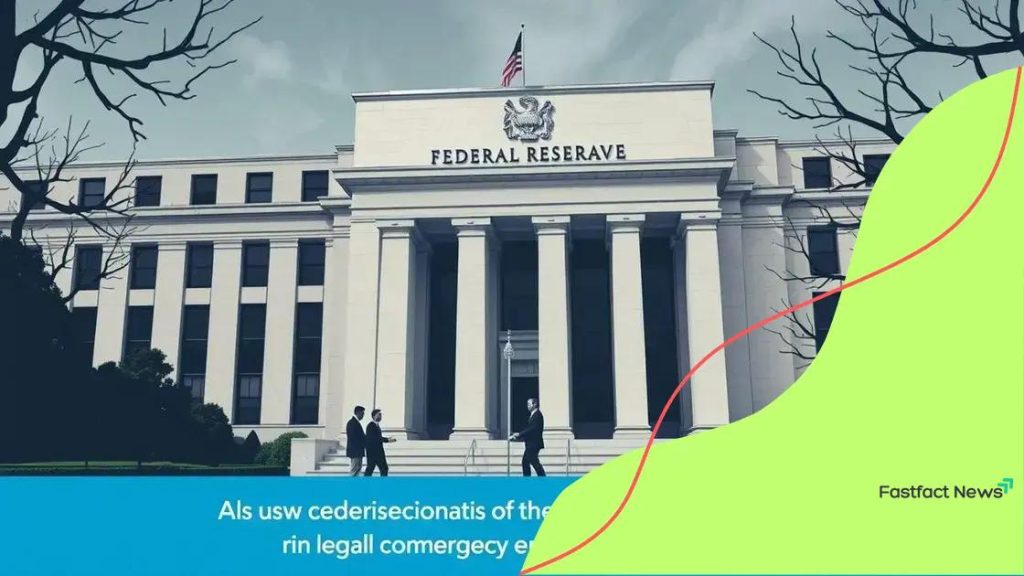Federal Reserve emergency lending: what you need to know

Anúncios
Federal Reserve emergency lending provides crucial financial support to banks and other institutions during crises, promoting liquidity and stabilizing the economy by preventing bank failures and encouraging lending.
Federal Reserve emergency lending plays a critical role in stabilizing the economy during crises. Have you ever wondered how this process impacts your financial life?
Anúncios
Understanding Federal Reserve emergency lending
Understanding Federal Reserve emergency lending is crucial for grasping how financial crises are managed. Many people might not realize the significance of this process in stabilizing the economy.
The Federal Reserve implements emergency lending during times of financial distress to provide liquidity to institutions. This helps prevent widespread panic and keeps the financial system functioning smoothly. Understanding its mechanisms is essential for everyone.
Key Components of Emergency Lending
There are several vital aspects to consider when discussing emergency lending:
Anúncios
- Credit Facilities: These are special programs established by the Fed to provide funds to banks and other financial institutions.
- Market Stability: Emergency lending aims to ensure that financial markets can operate even during turbulent times.
- Borrower Eligibility: Not all institutions can access these funds; they must meet specific criteria set by the Fed.
Many don’t realize that such lending can take various forms, including direct loans and asset purchases. Each of these methods serves a unique purpose in enhancing liquidity. For instance, when traditional borrowing slows, the Fed steps in to inject capital into the system. This process prevents banks from collapsing due to a lack of funds.
The Role of the Federal Reserve
The Federal Reserve’s role is not just about providing funds; it’s about instilling confidence. When institutions know they can access capital during a crisis, they’re less likely to hoard cash, which keeps money circulating in the economy.
Furthermore, it’s interesting how these measures can extend beyond banks. Sometimes, large companies facing liquidity issues may benefit from the Fed’s intervention, which indirectly supports jobs and consumer spending. By acting quickly, the Federal Reserve mitigates the effects of financial shocks.
Understanding how emergency lending works helps demystify financial systems. It is not merely a bailout but a proactive step towards maintaining stability and fostering trust among market participants.
Overall, emergency lending by the Federal Reserve illustrates the complexities of the financial system and the importance of swift action during crises. By learning about it, we become better equipped to navigate financial uncertainties in our own lives.
History and impact of emergency lending
The history and impact of emergency lending reveal its vital role during financial crises. Understanding this history helps us appreciate why such measures are essential.
Emergency lending has been part of the U.S. financial system for many decades. It gained significant attention during the Great Depression in the 1930s, when banks faced massive failures. The Federal Reserve started to recognize the need to support struggling financial institutions to maintain economic stability.
Key Events in Emergency Lending History
There are crucial moments that highlight the evolution of emergency lending:
- The Great Depression: This era marked the beginning of modern emergency lending. The Fed introduced several programs to help banks stay afloat.
- The 2008 Financial Crisis: This was a pivotal time for emergency lending. The Fed implemented substantial measures to rescue failing institutions like Lehman Brothers.
- COVID-19 Pandemic: In this recent crisis, the Fed expanded its emergency lending tools to support businesses and stabilize the economy quickly.
The influence of emergency lending extends beyond just preventing bank failures. It affects the broader economy by maintaining confidence among consumers and investors. For instance, when the Fed steps in to provide liquidity, it encourages banks to continue lending to businesses and families. This support helps keep the economy growing even during challenging times.
Moreover, the effectiveness of these measures can often be evaluated by how quickly the economy recovers post-crisis. Historical data shows that rapid responses often lead to shorter recessions. For example, after the 2008 crisis, the swift actions by the Federal Reserve were instrumental in helping the economy rebound within a few years.
Moreover, it’s noteworthy that while emergency lending can stabilize the economy, it also raises important questions about risk and moral hazard. When institutions know they might be bailed out, they may take on riskier behaviors. Balancing support with accountability is a challenge for policymakers.
How emergency lending supports financial systems

How emergency lending supports financial systems is a crucial topic for understanding economic stability. Emergency lending serves as a lifeline during financial turmoil.
When a crisis hits, the economy often experiences a sudden loss of liquidity. This situation can lead to panic, causing financial institutions to restrict lending, which may further slow economic activity. Emergency lending helps prevent this downward spiral by providing necessary funds to banks and financial institutions.
The Mechanisms of Support
Several mechanisms underpin how emergency lending supports financial systems:
- Liquidity Provision: Emergency lending provides cash to banks, ensuring they can meet their obligations. This liquidity helps avert bank runs.
- Market Confidence: By stepping in during crises, the Federal Reserve reassures businesses and consumers that the financial system remains stable.
- Access to Credit: When banks receive emergency funds, they are more likely to lend to individuals and businesses, promoting economic activity.
Furthermore, emergency lending fosters an environment where trust is established between financial institutions and consumers. When banks know they have a safety net, they are more willing to extend credit. This lending encourages investment and spending, key drivers of economic growth.
Additionally, the ripple effect of emergency lending goes beyond immediate financial aid. It can stabilize entire markets. For example, when the Fed intervened during the 2008 financial crisis, it not only supported banks but also restored faith in the housing and stock markets, enabling recovery.
Moreover, the global implications of emergency lending are significant. When the U.S. provides support, it often influences international markets, reinforcing a more stable global economy. Other countries may adopt similar strategies, creating a cooperative effort to mitigate crises.
Current trends in Federal Reserve emergency lending
The current trends in Federal Reserve emergency lending reflect the ongoing changes in the economic landscape. As the global economy evolves, so too do the strategies and focus areas of emergency lending.
One notable trend is the expansion of lending facilities during times of crisis. For instance, during the COVID-19 pandemic, the Federal Reserve introduced several new programs to address unique challenges. These included facilities aimed at supporting small and medium-sized businesses, which had not been a primary focus in previous crises.
Innovative Lending Programs
The Federal Reserve has launched several innovative lending programs that highlight these trends:
- Paycheck Protection Program (PPP): Designed to keep workers employed during the pandemic, this program provided loans that could be forgiven if businesses maintained their payrolls.
- Municipal Liquidity Facility: This facility was established to provide direct loans to municipalities, helping them manage unexpected costs due to the pandemic.
- Main Street Lending Program: Aimed at supporting small and medium-sized enterprises, this program facilitated access to credit for businesses that were in good financial standing before the crisis.
Additionally, the Fed has been more transparent about its lending practices and the criteria used to select eligible borrowers. This increased transparency helps build trust with the public and ensures that funds are allocated efficiently.
Another trend worth noting is the focus on long-term economic recovery. The Federal Reserve is not just concerned with immediate liquidity but is also looking at how to support sustainable growth post-crisis. This involves considering environmental sustainability and equitable access to resources.
Moreover, the Federal Reserve has acknowledged the importance of digital transformation in banking. As more financial activities move online, there is an increased emphasis on ensuring that emergency lending mechanisms are accessible and efficient in digital formats.
Future outlook for emergency lending strategies
The future outlook for emergency lending strategies is critical in a rapidly changing economic environment. As challenges evolve, so must the approaches that the Federal Reserve and other institutions use to respond.
One of the key trends is the emphasis on adaptability. Future emergency lending strategies will likely be designed to respond swiftly to various economic shocks. This means creating flexible frameworks that can be adjusted based on the specific nature of a crisis.
Integration of Technology
Another important aspect will be the integration of technology. Digital tools can streamline the lending process and make it more accessible. The Federal Reserve may increasingly utilize technology to:
- Enhance Speed: Using digital platforms can speed up the application and approval processes, getting funds to those in need more quickly.
- Improve Data Analysis: Advanced data analytics can help identify which sectors require support and how to tailor assistance effectively.
- Expand Outreach: Technology can help reach underserved populations, ensuring that emergency lending is equitable and inclusive.
Moreover, future strategies are expected to focus on collaboration with private sector institutions. Creating partnerships can lead to more robust support systems and shared resources during crises. By working together, the Federal Reserve and private banks can develop comprehensive solutions that address the unique needs of different sectors.
Additionally, sustainability will play a key role in shaping future lending approaches. The Federal Reserve may consider the environmental impact of lending decisions, supporting initiatives that promote sustainability alongside economic recovery.
Finally, there is an anticipated shift towards transparency and accountability. Stakeholders and the public demand clear communication on how funds are distributed and the outcomes of emergency lending initiatives. Ensuring that processes are transparent will build trust and foster cooperation in economic recovery efforts.
FAQ – Frequently Asked Questions about Federal Reserve Emergency Lending
What is Federal Reserve emergency lending?
Federal Reserve emergency lending provides financial support to institutions during crises to ensure liquidity and economic stability.
How does emergency lending impact the economy?
Emergency lending helps prevent bank failures and promotes lending to businesses and consumers, fostering economic growth even in tough times.
What are some examples of recent emergency lending programs?
Recent programs include the Paycheck Protection Program (PPP) and the Municipal Liquidity Facility, aimed at supporting businesses and municipalities during the COVID-19 pandemic.
Why is transparency important in emergency lending?
Transparency builds public trust and ensures that funds are allocated appropriately, allowing for effective scrutiny of the lending processes.
